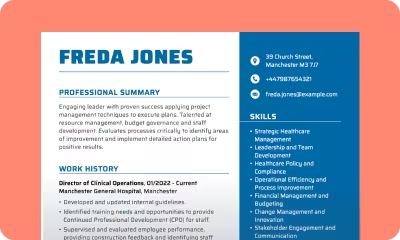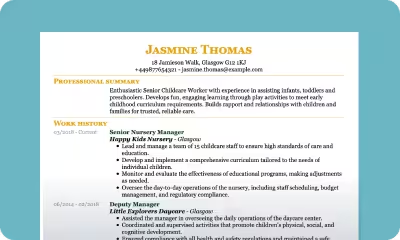- Our customers have been hired by : *Foot Note
The perfect architect CV illustrates your passion for construction design, specialist skills, and eye for detail. It should include your top skills, like CAD design and structural engineering, and highlight your experience by listing specific roles and responsibilities to attract the attention of eagle-eyed recruiters.
Whether you’re a trainee or an experienced professional, architect CV examples can help you land your next role. Learn how to make your CV stand out with our expert guidance for architects, then see how it’s done with our architect CV sample.
Keep reading for:
- Sample architect CV
- Architect CV templates
- Tips for formatting your architect CV
- Step-by-step guide for writing your architecture CV
- Top dos and don’ts for an architect CV
- FAQs about the role and architecture CVs
SEARCH ALL CV EXAMPLES
Sample architect CV
Eric King
5 Browns Road
Liverpool L3 9RF
07912 345678
eric.king@example-example.co.uk
Professional summary
ARB qualified Architect with 10 years of commercial and residential experience. Creating innovative, cost-effective specialisations for private and commercial projects, ensuring timely completion for maximum stakeholder satisfaction.
Skills
- CAD design
- Commercial architecture
- Structural engineering
- Meticulous attention to detail
- Modular construction methods
- Material application knowledge
Work history
Architect (Oct 2018 – Current)
Madewell Partners, Liverpool
- Coordinated with clients, consultants and contractors during construction bidding.
- Consulted with clients to determine functional and spatial requirements of new structure.
- Created, printed and modified drawings in AutoCAD and Revit.
Project Architect (Feb 2014 – Sep 2018)
Freelance, Liverpool
- Liaised with stakeholders and clients to review drawings, materials and samples, ensuring quality standards met project needs.
- Maintained continued adherence to UK building regulations for optimal project compliance.
- Carefully managed project costing, regularly reviewing spending and material pricing to stay under budget.
Junior Architect (Jan 2009 – Feb 2014)
Allen, Smith & Partners, Liverpool
- Presented accurate, detailed working, drawings and material specialisations, enabling smooth-running production processes.
- Communicated with vendors and contractors to incorporate input in residential project designs.
- Recommended minor adaptations and modifications to complete working drawing sets.
Education
Master of Arts: MArch Architecture (2008)
Liverpool John Moores University, Liverpool
Bachelor of Arts: BA (Hons) Architecture (2006)
Liverpool John Moores University, Liverpool
Certifications
Registered Architect – Architects Registration Board (ARB)
Chartered Member – RIBA
Registered Architect – Architects Accredited in Building Conservation (AABC)
The best format for your architect CV
A well-structured CV not only highlights your qualifications and experience but also demonstrates your attention to detail and organisation, which are critical skills for architects. That’s why choosing the right CV format for your architecture application is essential to showcase your expertise effectively.
The two most commonly used CV formats are reverse chronological and skills-based. Which should you choose for your CV and why?
The reverse chronological format is ideal for architects with relevant work experience. This format organises your work experience by starting with your most recent position, followed by your earlier roles. Here’s why it may work well for you:
- Highlights career progression: Recruiters can quickly see how your responsibilities and expertise have developed over time.
- Focuses on relevant experience: Architecture is a field where recent projects often demonstrate the most up-to-date skills, and this format ensures they are prioritised.
- Preferred by recruiters: This traditional format is widely accepted and allows recruiters to quickly assess your career path and achievements.
The skills-based format is suitable for architects who may have employment gaps, are transitioning from another industry, or have extensive freelance or project-based experience. This format organises your CV around key skills rather than a chronological timeline. Here’s why it might be a good choice:
- Emphasises transferable skills: For architects entering the field from a different background, this format highlights design, technical, and project management skills up front.
- Covers career gaps: This format minimises the focus on employment data, encouraging recruiters to assess your skills and achievements instead.
- Demonstrates flexibility: If you’ve worked on a variety of freelance projects or short-term roles, this format allows you to group experience by skill or project type.
How to write an effective CV for an architect
Creating an impressive CV is essential for architecture roles, and it all starts with presenting the right combination of academic achievements, qualifications, and relevant experience.
Use our Architect CV sample as a guide. Remember key tips such as structuring your CV effectively, making it professional and including essential content to showcase your expertise.
- Adding contact details to your architect CV
- Writing your architect CV’s personal statement
- Adding an experience section to your architect CV
- Top skills for your architect CV
- Outlining education on an architect CV
Adding contact details to your architect CV
Start your CV with your contact details; place them at the top of the page. Include your name, address, phone number, and email. Make sure this information is up to date and looks professional. If you’re submitting a cover letter with your application, it’s important to check that the contact section of the letter matches the one on your CV.
Example of contact section for an architect CV
Eric King
5 Browns Road
Liverpool L3 9RF
07912 345678
eric.king@example-example.co.uk
Writing your architect CV’s personal statement
Sitting at the top of your architect CV, a personal statement (or professional summary) is essential to introduce you to recruiters and engage them with your CV. Highlight key UK architect qualifications like ARB registration or an ARB-approved degree if you’re a trainee. Within three to four sentences, you should also mention a few skills that best define you, such as attention to detail or innovative thinking.
Although your personal statement is at the top of the page, we recommend completing it last. By ensuring that the rest of your CV is completed before you get to your professional summary, you can create a summary that provides an accurate overview of the skills and experience you’ve chosen to list in other sections of your CV.
Example of personal statement for an architect CV
A highly skilled architect with over 8 years’ experience, specialising in the design of innovative and sustainable solutions for residential, commercial and urban projects. Experienced in project management, 3D modelling and working with multi-disciplinary teams to deliver functional and visually pleasing structures on time and within budget. Notable achievements include leading the design of a £10 million mixed-use development and achieving LEED Gold certification for a major office project.
Adding an experience section to your architect CV
Your work experience section is a key opportunity to show how your contributions have shaped successful architectural projects. In this part of your architect CV you can demonstrate your design expertise, project management skills, attention to detail, and ability to work with multidisciplinary teams. By following our tailored advice, you can ensure that your CV matches the expectations of architectural roles and effectively highlights your professional impact.
Use the example below to structure your work experience section for clarity. This format will help you showcase your achievements, responsibilities, and how you’ve contributed to the projects’ success. Here’s what to include in the work experience section of your architecture CV:
- Job title: If your job title is not commonly known, you can clarify it with a brief description. For example, instead of just “Architect”, you could say “Junior Architect – Design Specialist” to give more context.
- Start and end dates: The dates you worked in each role provide a timeline of your work experience, so it’s important to be clear and accurate. Use the month/year – month/year format.
- Company name and location: Including the company name and location ensures that recruiters can see where you’ve worked, which helps to contextualise your experience. For smaller companies or freelance work, include all relevant information to highlight achievements and demonstrate versatility.
- Key responsibilities and achievements: Include specific examples such as designing award-winning projects, achieving sustainability certifications, managing project budgets or leading cross-functional teams.
Example of work experience for an architect CV
Senior Architect
UrbanVista Designs, London
May 2022 – Current
- Led design and project management for residential, commercial, and mixed-use developments valued at up to £15M, ensuring timely delivery within budget.
- Coordinated with contractors, engineers, and clients to resolve design challenges, ensuring compliance with UK building regulations and client specifications.
- Spearheaded the implementation of BIM processes, enhancing project efficiency and collaboration across multidisciplinary teams.
- Mentored junior architects, fostering a culture of innovation and excellence in design.
Architectural Assistant
GreenBrick Studios, Manchester
July 2019 – April 2022
- Supported senior architects in designing and developing residential and commercial projects across the North West.
- Prepared detailed technical drawings and planning applications, achieving approval for multiple high-profile developments.
- Conducted site visits to assess progress and ensure adherence to specifications and safety standards.
- Utilised Revit and AutoCAD to produce 3D models and visualisations for client presentations.
Top skills for your architect CV
To work as an architect you’ll need a specific set of technical and personal skills. Architecture requires a balance of artistry and practicality, as architects are responsible for designing buildings and spaces that are not only aesthetically pleasing but also functional, safe, and sustainable.
In addition to a strong creative vision, they must be able to solve complex problems efficiently and meet their clients’ needs. They must also be meticulous and detail-oriented, ensuring that every aspect of their design is executed to the highest standard.
The role requires an in-depth understanding of various disciplines, including legislation and building codes. A successful architect also knows how to work independently and collaboratively with other specialists, such as engineers, contractors, and town planners.
Essential skills for an architect
- High level of creative vision
- Critical thinker
- Practical design knowledge
- Numerical skills
- Comprehensive understanding of environmental factors
- Detail-orientated
Desirable aptitudes to set you apart
- Excellent communication
- Passion for the job
- Team player
- Time management
- Budgeting
- Working under pressure
Outlining education on an architect CV
In the UK, architect qualifications are covered by a degree recognised by the Architects Registration Board (ARB) and the Royal Institute of British Architects (RIBA). To gain entry on your degree course, you’ll typically need relevant A-levels such as Maths, Art, Design and Technology, and IT.
These subjects provide a strong foundation in both the creative and technical aspects of architecture. Your course will typically consist of a three-year Bachelor of Arts or Science in Architecture, followed by a two-year Master of Architecture.
When structuring your CV’s education section, it’s important to include your architectural qualifications to ensure you meet the necessary criteria for UK employers. ARB registration is a minimum requirement for most architectural roles, so be sure to mention this in your personal statement and include the specific courses, dates and any professional qualifications in the education section of your CV. This will highlight your formal qualifications and demonstrate your readiness to take on the responsibilities of an architect.
Here are some additional tips for writing your education section:
- Highlight relevant qualifications: Make sure you include your ARB registration and RIBA accreditation. Include your course titles, institutions and graduation dates to provide a clear overview of your education.
- Highlight your thesis or special projects: If you worked on an impressive dissertation or notable design project during your studies, include it in your CV. This can demonstrate your creative and technical skills and provide an insight into your architectural focus.
- List your A-levels: If applicable, include your A-level subjects and grades, particularly if they’re relevant to your architectural training.
Example of education for an architect CV
Master of Architecture (MArch)
University of London, London
Graduated: September 2017
- Accredited by the Architects Registration Board (ARB) and the Royal Institute of British Architects (RIBA)
- Specialisation in Sustainable Design and Urban Regeneration
- Dissertation: “Reimagining Urban Spaces: Integrating Green Architecture into Urban Design”.
Bachelor of Arts in Architecture (BA Arch)
Manchester School of Architecture, Manchester
Graduated: July 2014
Top dos and don’ts for architect CV writing
Do
DO tailor your architect CV to the role
Each architecture role is unique, so tailor your CV to highlight the skills and experience most relevant to the role. Focus on key projects, software skills, and specific areas of expertise that align with the job description to make your CV stand out to recruiters.
DO use the right file type
Be sure to check the job ad to see whether recruiters have requested CVs in a specific file type. Word is often recommended because it’s compatible with applicant tracking software (ATS). However, you could also opt for PDF, which will ensure the design and formatting stay the same on any device or program.
Don't
DON'T overcrowd your architecture CV
While it’s tempting to list every skill and project you’ve worked on, your CV should be concise and focus on your most impressive achievements. Avoid overwhelming the reader with unnecessary details; instead, highlight the most relevant and impactful information that demonstrates your qualifications.
DON'T forget to proofread
Attention to detail is crucial in architecture. Before downloading your architect CV, make sure you read through it to ensure everything is present and correct. That includes the right phone number and email address so recruiters can reach you without any issues.
Your architect CV questions answered
Should I attach a portfolio to my architecture CV?
Yes, it’s highly recommended that you include a portfolio with your architectural CV. It allows you to showcase your design skills and experience through visual examples such as CAD drawings, 3D models, and photographs of completed projects. You can include a link to an online portfolio or attach a PDF. Make sure the file size is manageable for easy viewing.
How do I highlight my architectural design skills on my CV?
When showcasing your design skills, focus on specific projects you’ve worked on, detailing the creative and technical aspects. Mention any computer software tools you’re familiar with (e.g. AutoCAD, Revit, Rhino) and include examples of innovative design solutions you’ve implemented. If possible, provide links to a portfolio of your work.
What are the responsibilities of an architect?
An architect’s job is to design and develop commercial and industrial building projects from early concept through design development. They will also need to consult with builders and clients to ensure they are satisfied that the job is done to the correct specifications.
How do you become an architect (UK)?
After graduating with an ARB-recognised degree, you will need two years of professional experience – comprising work experience and practical training. This is followed by a final exam, after which you will become a registered architect.
What is an architect's salary?
The salary for a registered architect is around £40,000 on average. You can expect a trainee salary of around £25,000 at the start of your career. Architects with lots of valuable experience can earn upwards of £60,000.
Build your architect CV today
Construct a well-rounded and impressive architect CV today using our proven CV builder. Find all the architect CV templates, examples, and content you need to tailor your application, impress your future employers and make the forward-thinking steps in your career.
*The names and logos of the companies referred to above are all trademarks of their respective holders. Unless specifically stated otherwise, such references are not intended to imply any affiliation or association with myperfectCV.




